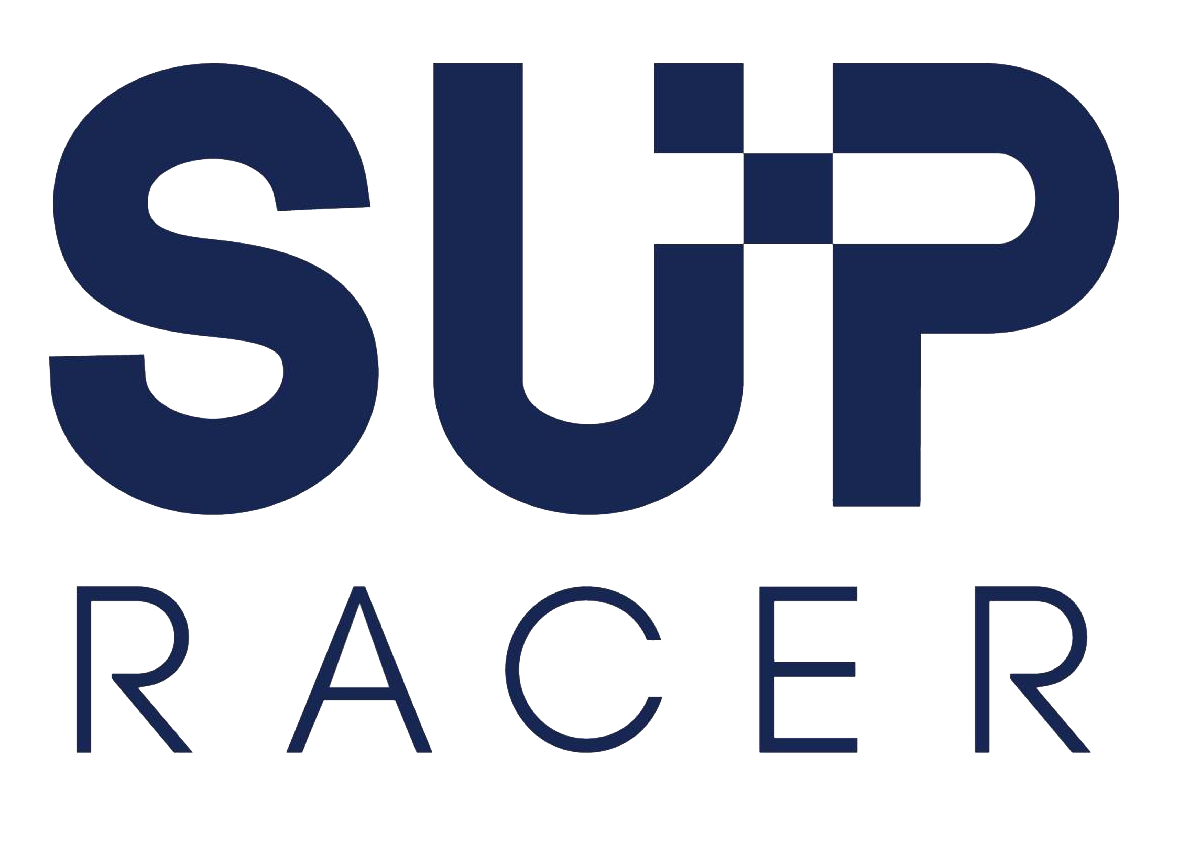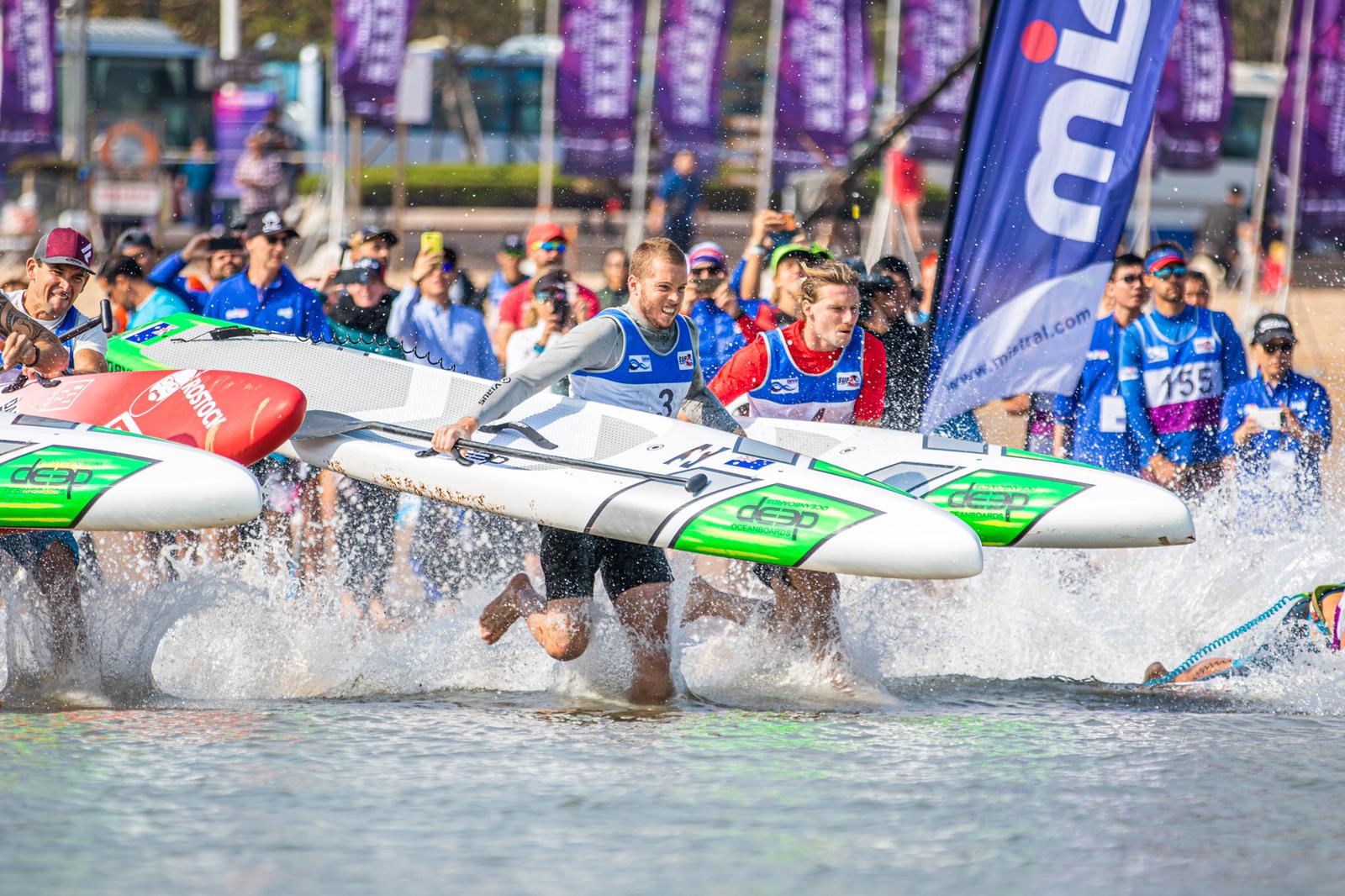
Jim Terrell: The Death & Rebirth Of SUP Racing (aka The New 4 Metre International Stock Class)

Boss Man’s note: Jim Terrell is one of the most influential figures in Stand Up Paddle racing. As a 4x time Olympian, founder of the iconic Quickblade Paddles and an established SUP racer in his own right, Jim is in a unique position to comment on the current and future trends impacting our sport.
The debate about board classes and design restrictions has been raging for months now (partly thanks to us) and now the Mad Scientist is having his say. Jim believes the sport is at huge risk due to radical new designs, and that something has to be done to save it. During his time in canoe racing, Jim had his finger on the pulse of board design evolution more than perhaps any other paddler in the world. He’s seen this exact same problem (and fierce debate) before, when Olympic and Marathon Canoeing went through extreme growing pains as designs became too extreme and inaccessible for beginners.
So read the guest post from Jim Terrell below. It’s a controversial one for sure… But whether you love it or hate it, leave your comment as we’d really like to hear your thoughts.
*****
UPDATE: Jim responds to your questions in “The New 4 Metre International Stock Class, Part II”
*****
The Death & Rebirth Of SUP Racing (aka The New 4 Metre International Stock Class)
by Jim Terrell
We can surely all agree that Stand Up Paddleboard Racing has become one of the fastest growing water sports in history. Why? Because SUP racing is for everyone; young and old, male and female who is looking to get out on the water, have fun and get a great workout.
Our sport has deep roots in the surf culture, which is considered to be cool in pretty much all parts of the world. That’s an association I don’t think we can afford to lose, but we may be doing just that if board designs continue the way they’re going.
SUP race boards have been shaped and designed by some of the most creditable surfboard shapers in the world for several years now. Names such as Ron House, Joe Bark, Mark Johnson (Hobie), Gerry Lopez, Dick Brewer, Micky Munoz, Jimmy Lewis and Russ Coble (Ohana) have all taken a turn at shaping SUP boards for races since the very first BOP.
I realized very early on (around 2006) after a conversation with Laird Hamilton that SUP Racing could be and would be a popular activity worldwide, not only in our oceans but also in rivers and lakes far from the coast. SUP started in the ocean but the growth is going to come on flat water.
Stand Up Paddleboarding (and SUP racing in particular) is a way for people to connect with surfing, even if they’ve never seen waves and live away from the coast.
So I believe it’s no mystery why we’re seeing a growing number of SUP races happening all over the world, on all bodies of water, from Lake Ontario and Lake Michigan, to the Ohio and Tennessee Rivers, to right here in Lake Brombachsee, Germany, where hundreds of paddlers from over a dozen countries just completed three days of SUP racing on flat water. Yes, that’s right, flat water.
I’m a 4-time Olympic Canoeist who is all too familiar with flat water racing and I knew this day would come, and I embrace it.
However this new interest in SUP racing on flat water raises one big fear for me, that we’re going to see our user-friendly sport slowly deteriorate from the threat of specialized, hi-tech equipment that doesn’t have user-friendly shapes or consumer-friendly prices. We’re going to see race boards that are impossible to paddle for all but the most elite, well-balanced paddlers. We’ll lose the accessibility that made this sport so popular in the first place. And we’ll also lose our association with surfing altogether.
This fear is coming from me, a guy that’s all about pushing the envelope for speed and performance. The way I see it, even as a former Olympic Canoeist familiar with racing canoes of 17 feet in length and 16 inches in width, if SUP boards continue evolving the way they are, it’s going to become a ridiculous balance contest that deters people from participating and eventually kills the sport.
I could see it coming over the past couple of years and even built a few radical-looking (and radically-fast) hi-tech carbon shapes to stir up some welcome protests from other racers.
Just check out this video below… this is an 11 inch wide board. 11 inches… eleven! That’s less than half of what the narrowest production boards are today. The deck is 16 inches wide but the effective water line (i.e. the real width) is only 11 inches, closer to a high performance high-kneel canoe than a SUP race board.
I didn’t make this board to gain a sneaky advantage and win races (though I could certainly use it for that if I wanted). I built it to show everybody where the sport of SUP racing is headed, and where it’s eventually going to get to if we don’t do something about it sooner rather than later.
Watch the video again. Is this where we want to see our sport go?
I don’t think so.
We already have this sport in the Olympics: Canoeing. It’s been there since 1936.
It’s a sport that requires a huge commitment of time and patience to excel at the top level and is extremely challenging for beginners. Why? Because there is no minimum width requirement and the canoes are super tippy, especially if you take up the sport in your twenties or later.
In the last three years I’ve seen most competitive SUP race boards on the market evolve from around 26-28 inches to around 22-24 inches. That’s more than a 15% decrease in just two years. Where will it stop? And where will it become too challenging for the average paddler?
This is not a new problem for paddle sports. In the mid 1900’s, Marathon Canoe Racing in the Midwest U.S. went through this same dilemma; canoes were getting faster and faster yet tippier and tippier, to the point where it became more of a balance contest than a test of strength and endurance.
The Marathon Canoe governing body chose to adopt a rule to regulate minimum width as well as maximum length. This was a good thing for the sport, but where they fell short may have been that they chose not to adopt a minimum weight requirement. As technology advanced and kevlar, honeycomb core and “aerospace” vacuum bagging technology were adopted by the leading manufacturers, the cost of competitive race canoes rapidly jumped. Combined with rising fuel prices at the time, we immediately saw a decline in race participation as it simply became too expensive for most paddlers.
Many canoe races that had been run for 20 years and longer in local towns totally disappeared by the mid to late 80’s.
Olympic Canoeing went through the same problem. As canoes became skinnier and lighter, the governing body chose to adopt a rule to keep designs realistic, somewhat user-friendly and to protect the growth of the sport.
Just like Marathon Canoeing, Olympic Canoeing also introduced some specs, which included maximum length, minimum weight and also a minimum width.
So where did they go wrong? They didn’t specify clearly in the rules that the minimum width requirement should be at the waterline or below. So over time canoe designs started to look really odd, as manufacturers used this loop hole to create faster and faster (yet tippier and tippier) canoes that technically met the minimum width requirement at the beam level (i.e. top of the canoe) but could be as narrow as they liked on the waterline, which in reality is the actual width of the canoe.
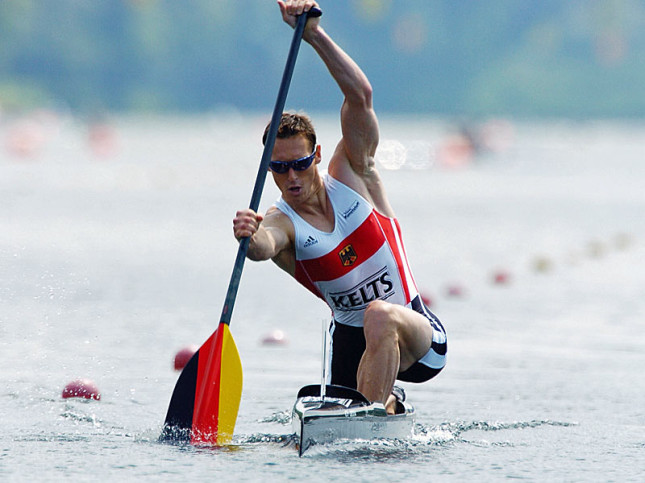
This is what modern racing canoes look like. They’re narrow. Really narrow. And the scary part is: If this guy (Olympic champion Andreas Dittmer of Germany) were to lift his back knee by just an inch, he’d technically be doing Stand Up Paddling… Is this what we want the sport to look like?
It got so out of hand and had progressed so far past the point of no return that the governing body simply scrapped the width requirement altogether around ten years ago. Today the sport of Olympic Canoeing (C1) is in decline, and I believe that’s because it’s so inaccessible to beginners. It takes a LONG time to learn how to paddle one of those things, yet somebody can jump on a SUP race board and be paddling (and racing) almost straight away.
So what do we do with SUP race boards?
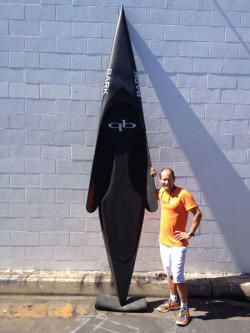
The Bat Board. I built this to show what SUP race boards *shouldn’t* look like… even if this is faster, it’s wrong in my opinion.
I’ve discussed in the past how I think we have too many board classes. The 12’6, 14′ and Unlimited classes (yes, that age old debate). In my opinion we have at least one too many.
For races like Molokai and downwind/ocean events, I’m all for the Unlimited class. So let’s keep that class.
I think the real problem is 12’6 vs. 14′. One of those has to go.
For the future health of our sport, I think one of them (or both of them) need to be eliminated. There’s too much fragmentation and confusion that’s hurting the sport. Just look at Europe the past few weeks; guys have had to travel from Australia and the U.S.with two boards. They race a 12’6 one week and then a 14′ the next. It’s the same problem at the Battle; 12’6 in the Elite Race, 14′ in the Distance Race.
So how do we unify the standard board class?
Well how about this idea of mine. And hear me out…
Most of you know how the 12’6 SUP race board was invented. The first Battle of the Paddle (in 2008) set the standard, for better or worse, and that’s how it’s stayed since. Most races around the world are influenced by the BoP to some degree. Despite all the different associations trying to have their say, the Battle always has been (and possibly always will be) the standard bearer for our sport.
So the Battle of the Paddle organisers decided on a 12’6″ length limit in the first year and now we’re stuck with it, right?
Or are we?
Imagine this…
The BoP announces that for the 2015 event, the length limit of the Elite Race will be increased to 4 metres. And the length limit for the Elite division of the Distance Race will be reduced to 4 metres.
Yes, that’s right, 4 metres.
(that’s just over 13’1″ for my fellow Americans…)
4 metres. That’s almost perfectly mid-way between a 12’6″ and a 14 footer, plus it’s an easy, even length for all of our international paddling friends. 4 metres. 400 centimetres.
We could call it the 4 Metre International Stock Class. Or just the 4 metre class. Or eventually just the “stock class”.
I believe this would unify the two main board classes and make our sport much less confusing. If we all moved towards 4 metres, eventually the 12’6 and 14′ classes would just fade away.
This would solve a few big issues: the fragmentation of board classes in our races, having to travel with multiple boards, and the confusion for first time racers who don’t know what length board they’re supposed to buy. It would simplify our sport, and I believe it would help grow it as well.
But that’s not all…
The BoP also announces that for 2015 boards have to be at least 55cm wide (21.65 inches) at the 7cm (2.75 inches) deep waterline (this can easily be measured and I can show you how). The Battle already requires athletes to measure their board for length, so this will be done at the same time and take an extra 10 seconds.
But wait, that’s not all…
The BoP also decides to require that all boards from 2015 onwards must weigh a minimum of 9kg (19.8 lbs). Boards weighing less have the option of securing a small weight to get it up to standard.
But that’s not all folks…
The BoP also decides that no board will be allowed any more than a 7cm low point (concavity shape) below any other two points on the deck’s surface (this can also be easily checked and measured at “board control” in just a few seconds, and again I can show you how).
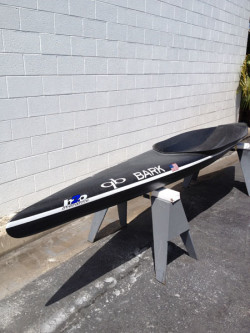
The Quickblade Canoe. I built this as a canoe/paddleboard hybrid, and I don’t think it should be legal in SUP races…
WHY?
Why so many damn specs?
Keep it simple why don’t we!?
You’re kidding me right Jim?!?
No, no and no.
Here’s why I believe this is so important (in fact I’d say it’s critical to the future of the sport)…
The new length requirement (rule #1) solves the problem of fragmentation and “too many board classes” by unifying racing under a common class.
The width requirement (rule #2) stops the sport from evolving like canoeing did, to the point where it’s a balance contest between the lightest and most agile paddlers, rather than a test of strength or endurance.
The weight requirement (rule #3) stops the sport from evolving into an arms race where only the richest can afford the competitive boards. Again, I saw this happen first hand in canoe racing…
The deck depth requirement (rule #4) stops the sport from evolving from “Stand Up Paddleboarding” into “Stand Up Canoeing”.
Yes, a lower centre of gravity makes you go faster. Of course. But we already have canoeing. It’s been in the Olympics for almost 80 years. And it’s in decline. SUP is a new sport, it’s a unique sport and it has a proud heritage in the world of surfing. I believe we have to keep our boards looking something like surfboards, and NOT like canoes. Even if it means we’re going a little bit slower, I very strongly believe it’s for the good of the sport. If you want to go as fast as possible on the water, you’re in the wrong sport already.
And this is coming from me, an Olympic Canoeist. I’d personally have the most to gain if our sport evolved away from surfing and towards canoeing. I could bust out my 11 inch board and beat guys that are half my age and twice as fit as I am, just because I’ve grown up paddling narrow canoes and know how to balance in one. In fact in my old training days I used to stand up in my high-kneel canoe all the time for a bit of fun. I was technically doing SUP racing in the 80’s!
If you look at it from an extreme angle, Stand Up Paddling is actually already in the Olympics. If you take an Olympic Canoeist (such as the guy in the picture up above) and get them to raise their back knee just a few millimetres off the bottom of their canoe, they’re technically (and legally) performing Stand Up Paddling.
Right now there’s nothing stopping a canoe racer from turning up at a SUP race in their C1 canoe, lifting their back knee ever so slightly and smoking the field.
So again, surely we don’t want our sport to become Stand Up Canoeing. Right?
But back to the 4 Metre International Stock Class (or some other clever name that we can come up with, like the “Mad Scientist Class”… just kidding). How’s it going to work exactly?
Let’s say we bring it in during the 2015 (or even 2016) BoP, and announce it a year or two ahead of time, then manufacturers will have a full design & production cycle to build new boards specifically for this international standard.
At the end of the day, this all means that boards will stay relatively user friendly, both in terms of performance and price.
Yeah, it’ll be a bit messy for a couple of years, but I believe in the long-term our sport will be much simpler and much healthier. Some short-term pain for long-term gain.
And if you’re saying “You can’t paddle canoes in the ocean anyway, why is this relevant to the BoP?” keep in mind that the BoP is the standard bearer for our sport. Again, whether that’s right or wrong is irrelevant, it’s just the way the sport of SUP racing has developed. Most races all over the world, many of them on flat water, are using the same rules as the Battle.
So there you go: The New 4 Metre International Stock Class. No more 12’6 boards. No more 14′ boards. It’s all about 4 metre boards from now on (or from 2015 on…).
You may or may not agree with me here, but keep in mind my first love was canoeing and kayaking, and it still is. I’ve simply just fallen in love with SUP as well.
That’s SUP: Stand-Up-Paddling.
Not SUC: Stand-Up-Canoeing.
Not SDP: Squat-Down-Paddling.
Not SWYF4FAFTFFEOWPOJOSP: Stand-With-Your-Feet-4-Feet-Apart-Front-To-Back-From-Each-Other-While-Paddling-On-Just-One-Side-Paddling.
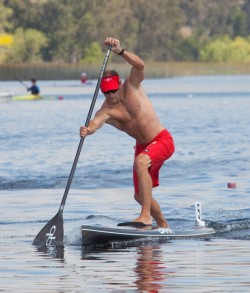
Who would do something like that, right..?
Talk about controversy; I did just that (at the Silver Blade Regatta two years ago) to show what could happen to our beloved sport and see what the reaction would be.
It’s the same way I made freaky looking, narrow ass boards to show what will happen if we don’t bring in regulations.
I’m not some guy that’s jaded about the faster boards beating me in races. I’ve built some of the fastest boards, and I don’t want to see them being raced!
So let’s just say we bring in this new 4 metre class. What’s gonna happen next?
Over time, maybe two years, all races around the world will start following suit with the BoP and adopt this new class as a standard. No more 12’6 vs. 14′ races, we’re all on the same thing: 4 metres.
Eventually, hopefully, the 12’6 and 14′ classes would simply fade away and we’d have a unified, standard, stock class.
Obviously there would be a transition period where there’s still a bunch of 12’6 and 14′ boards out there, so what would happen to them?
12’6 boards are still free to compete in the 4 metre class, though 14′ boards would not be. But before you jump up and down and say you just wasted two grand on a fourteen footer, or that you’re at a disadvantage coz you can’t afford to trade up from a 12’6 to a 4 metre board, consider this: At the speed race boards are evolving right now, your current 12’6 and 14′ boards are going to be obsolete in two years anyway!
What are you going to do with your 28 inch wide board when the pros are on their 18 inch wide boards?
We just finished the Lost Mills race here in Germany and I didn’t see one board over a year old near the front. Most of the models from two years ago, which were up around 28 inches wide, simply wouldn’t be competitive against the 22, 23 and 24 inch wide boards that many paddlers are racing today. And boards are only going to get narrower if we don’t bring in restrictions.
Plus all those beautiful 12’6 and 14′ boards would make great high-end touring boards for folks who want to paddle fast but don’t care about serious racing. And besides, this wouldn’t happen overnight, it would be transitioned in over a couple of years. You don’t have to find a 4 metre board tomorrow…
And again, I can’t say it enough; your board is going to become obsolete soon anyway! If you’ve been around serious SUP racing the past few years you’ll know exactly what I mean.
And if you’re no serious about racing, you can still compete on your 12’6 in the 4 metre class or your 14′ in the Unlimited class (which, as a side note, would see a rebirth in my opinion; the unlimited class would be the only other board class apart from the 4 metre class, and would be the only place where paddlers and shapers are free to experiment with all kinds of sizes and shapes).
The New 4 Metre International Stock Class.
I know… it’s a lot to swallow and at first glance maybe doesn’t sound so wise. But I believe our sport is in trouble and that we may need a solution. Fast. Otherwise there’s a good chance we’ll head down the path of canoe racing, where it’ll become an expensive balance contest rather than a test of strength and endurance.
So I hope you really think about this idea and find out what your SUP race board shaper thinks about it as well.
After all, I’m not called the MAD Scientist of SUP for no reason… too many epoxy fumes I guess.
– Jim
*****
Do you agree or disagree?
Got some suggestions, critiques or just plain old hate mail for Jimmy? We wanna know what you think…
LEAVE A COMMENT BELOW
*****
UPDATE: Jim responds to your questions in “The New 4 Metre International Stock Class, Part II”
*****
